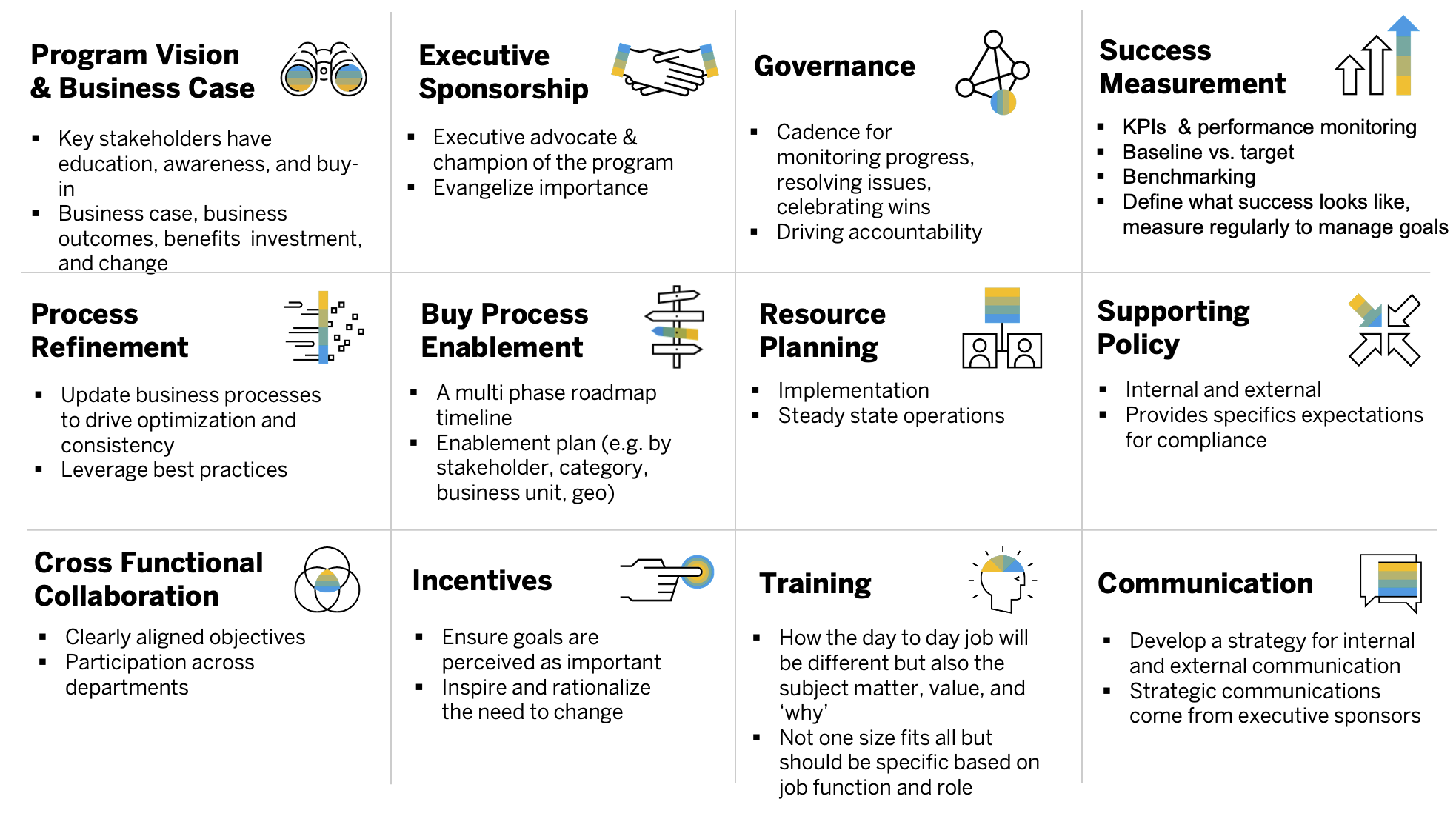
- SAP Community
- Products and Technology
- Spend Management
- Spend Management Blogs by SAP
- Navigating Change: Unlock Success & Overcome Adopt...
Spend Management Blogs by SAP
Stay current on SAP Ariba for direct and indirect spend, SAP Fieldglass for workforce management, and SAP Concur for travel and expense with blog posts by SAP.
Turn on suggestions
Auto-suggest helps you quickly narrow down your search results by suggesting possible matches as you type.
Showing results for
Product and Topic Expert
Options
- Subscribe to RSS Feed
- Mark as New
- Mark as Read
- Bookmark
- Subscribe
- Printer Friendly Page
- Report Inappropriate Content
02-10-2023
8:16 PM

As businesses continue to digitize and automate operations, many are turning to Procurement solutions to drive efficiency, reduce costs, and enhance compliance, however, the adoption of software can be challenging, and many customers face the same obstacles with effective implementation. In this blog, we will explore some of the key strategies, issues, pain points, and lessons learned when adopting technology-based Procurement solutions.
One of the biggest challenges with adoption is overcoming resistance to change. Many employees, especially those who are accustomed to manual or familiar systems, may be hesitant to adopt new technology and processes, I mean why should they if the new system is perceived to be more intelligent, more automated and can maybe think for itself – That said we are a long way away from this reality, nevertheless low user adoption massively hinders system usage.
It is crucial to plan and communicate effectively. This includes early stakeholder engagement which gains buy-in and support before end-user training is taken seriously by employees. Presenting the linkage between the new solution and the business strategy can help bridge the gap between being ‘asked’ to use the solution vs. understanding the value the solution brings to the company bottom line - According to a study by the Standish Group, 75% of ERP implementation failures are due to lack of user adoption. This underscores the need for effective change management strategies, such as training, communication, and support, to ensure that employees are fully on board and able to use the new procurement software effectively.
Companies that have successfully transformed their businesses with sustained improvements generally operate to or have their own version of the following 12:
- Program Vision & Business Case.Key stakeholders have education, awareness, and buy-in of the business case, business outcomes, benefits, investment, specific change expectations and understand the timeline required across the enterprise – Linking the business case to the overall corporate vision is key
- Executive Sponsorship. Executive sponsors provide guidance through the life of the program by helping to remove roadblocks and identify opportunities they also advocate and champion the program and evangelize the importance
- Success Measurements (KPIs, metrics, performance monitoring, baseline vs. target, benchmarking). 24% lower SG&A Expenses (% of revenue) for organizations where ownership and accountability has been assigned for all key metrics to ensure that mitigating actions are executed promptly once a metric falls out of the acceptable range*
- Buy Process Enablement (roadmap, timeline, plan). A phased approach where spend is enabled in waves to achieve business objectives over a defined period of time. Ensure this aligns to the timeline and ROI developed in the business case
- Governance. Establish a cadence for status updates with operational stakeholders on a more frequent basis (weekly/bi-weekly) and executive stakeholders (every 4 – 6 weeks) to monitor progress, resolve issues, celebrate wins and drive accountability
- Resource Planning & Organizational Structure. Sufficient, holistic, and cross functional resources for project execution, process mapping, configuration, supplier enablement (which includes testing, catalogues setup etc), as well as project oversight is essential. Also consider resources required for business as usual
- Policy. Establishes clear expectations, aligns to a corporate strategy, has executive sponsorship, and provides specifics expectations for compliance
- Cross Functional Collaboration. Remove silos, involve leaders and operators from many functions to align objectives
- Process Refinement. Clarity around process updates and redefining underlying business processes
- Training. Take the time to educate staff not only how they will be doing their job differently, but also the subject matter, value, and ‘why’ the change is being prioritized
- Incentives. Performance increased by an average of 22% when using incentive programs if selected, implemented, and monitored correctly
- Communication. Develop a strategy for internal and external communication and incorporate into the roadmap. Strategic communications come from executives and include value drivers, challenges, goals, benefits, and future vision.
I highly recommend you reach out to your Customer Success Partner and run your tailored Keys to success assessment that will help draft and define your Outcome Success Plan

Labels:
You must be a registered user to add a comment. If you've already registered, sign in. Otherwise, register and sign in.
Labels in this area
-
Business Trends
113 -
Business Trends
10 -
Event Information
44 -
Event Information
2 -
Expert Insights
18 -
Expert Insights
23 -
Life at SAP
32 -
Product Updates
253 -
Product Updates
24 -
Technology Updates
82 -
Technology Updates
13
Related Content
- Navigating the Risks of Sourcing Outside Your eSourcing Platform in Spend Management Blogs by SAP
- Can Procurement overcome challenges with Sustainability, Digital Innovation and Uncertainty? in Spend Management Blogs by SAP
- Procurement Definition, A Historical and Future Perspective in Spend Management Blogs by SAP
- The Procurement Monthly - December 2023 in Spend Management Blogs by SAP
- AI Predictions on the Procurement space for 2024 in Spend Management Blogs by SAP
Top kudoed authors
| User | Count |
|---|---|
| 4 | |
| 4 | |
| 3 | |
| 1 | |
| 1 | |
| 1 | |
| 1 | |
| 1 | |
| 1 | |
| 1 |